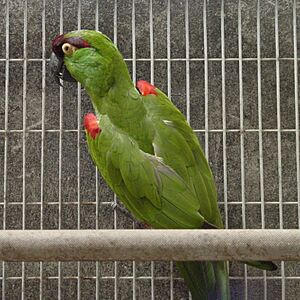Maroon-fronted parrot facts for kids
Quick facts for kids Maroon-fronted parrot |
|
|---|---|
 |
|
| Conservation status | |
| Scientific classification | |
| Genus: |
Rhynchopsitta
|
| Species: |
terrisi
|
 |
|
The maroon-fronted parrot (Rhynchopsitta terrisi) is a big, beautiful parrot. It looks a bit like a macaw. This parrot is mostly dark green. It has a special dark red patch on its shoulder. Its forehead and the stripe around its eyes are a deep maroon color. When it flies, the underside of its wings and tail look black. You might hear it make a high, rolling "cr-a ak" sound. If you hear a group of them from far away, they can sound like acorn woodpeckers. These parrots live only in northeastern Mexico. Sadly, there are only about 2,500 to 3,000 of them left in the wild.
Contents
What Does the Maroon-fronted Parrot Look Like?
The maroon-fronted parrot is a large bird. It measures about 40–45 cm (16–18 in) long. That's about the length of your forearm! It weighs between 390–470 g (14–17 oz). This is about the same as a can of soda.
Adult parrots have a dark maroon color above their eyes. This color goes over the yellow skin around their eyes. They also have a brighter red spot on the bend of their wing. Their tail is long and comes to a point. The underside of their wings looks black. Young parrots, called juveniles, have a pale beak. They have whitish rings around their eyes. They do not have the dark maroon stripe above their eyes yet.
Where Do Maroon-fronted Parrots Live?
Maroon-fronted parrots live in special forests. These are usually pine forests, or mixed forests with pine and other trees. They like to live at high places, from 2,000 to 3,500 meters up. That's like living on top of a tall mountain!
These birds are found only in the Sierra Madre Oriental mountains. This mountain range is in northeastern Mexico. You can find them in the states of Nuevo León, Coahuila, and Tamaulipas.
Maroon-fronted Parrot Behaviour and Life Cycle
Maroon-fronted parrots build their nests in large groups. They choose limestone cliffs near moving water. This helps keep their nests safe. They usually lay one to three eggs. This happens around July. The young birds, called juveniles, are ready to fly by November.
Their breeding time matches when pine trees produce their seeds. Pine seeds are the main food for these parrots. They also travel short distances during different seasons. This is called migration. They move to find the best food and nesting spots.
Protecting the Maroon-fronted Parrot
The maroon-fronted parrot is an endangered species. This means there are not many of them left in the wild. Their numbers are low because of two main reasons:
- Overgrazing: This happens when too many animals eat the plants in an area. It can harm the forests where the parrots live.
- Habitat destruction: This means their homes are being destroyed. Forests are cut down or changed, so the parrots lose their living space and food sources.
People are working to help these amazing birds. For example, the ITESM Campus Monterrey has programs to teach people about protecting the parrots. They also do science research in places like Cumbres de Monterrey National Park and Sierra de Arteaga. This research helps them learn more about the parrots. It also helps them find the best ways to keep the parrots safe.


